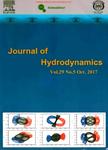Numerical prediction of effective wake field for a submarine based on a hybrid approach and an RBF interpolation
Numerical prediction of effective wake field for a submarine based on a hybrid approach and an RBF interpolation作者机构:Collaborative Innovation Center for Advanced Ship and Deep-Sea Exploration State Key Laboratory of Ocean Engineering Shanghai Jiao Tong University
出 版 物:《Journal of Hydrodynamics》 (水动力学研究与进展B辑(英文版))
年 卷 期:2017年第29卷第4期
页 面:691-701页
核心收录:
学科分类:12[管理学] 08[工学] 1201[管理学-管理科学与工程(可授管理学、工学学位)] 081104[工学-模式识别与智能系统] 0805[工学-材料科学与工程(可授工学、理学学位)] 0802[工学-机械工程] 0824[工学-船舶与海洋工程] 0835[工学-软件工程] 0701[理学-数学] 082401[工学-船舶与海洋结构物设计制造] 0811[工学-控制科学与工程] 0702[理学-物理学] 0812[工学-计算机科学与技术(可授工学、理学学位)] 0801[工学-力学(可授工学、理学学位)]
基 金:Project supported by the National Basic Research Development Program of China(973 Program Grant No.613134)
主 题:Submarine effective wake panel method Reynolds averaged Navier Stokes(RANS) radial basis function(RBF)
摘 要:A hybrid approach coupled with a surface panel method for the propeller and a Reynolds averaged Navier-Stokes(RANS) model for the hull with the propeller body forces are presented for predicting the self-propulsion performance and the effective wake field of underwater vehicles. To achieve a high accuracy and simplicity, a radial basis function(RBF) based approach is proposed for mapping the force field from the blade surface panels to the RANS model. The effective wake field is evaluated in two ways, i.e., by extrapolation from the flat planes upstream of the propeller disk, and by direct computation in a curved surface upstream of and parallel to the blade leading edges. The hull-propeller system of a real propeller geometry is further simulated with the sliding mesh model to numerically verify the hybrid approach. Numerical simulations are conducted for the fully appended SUBOFF submarine model. The high accuracy of the RBF-based interpolation scheme is confirmed, and the effective wake fraction predicted by the hybrid approach is found consistent with that obtained by the sliding mesh model. The effective wake fractions predicted by the two methods are, respectively, 4.6% and 3% larger than the nominal one.



